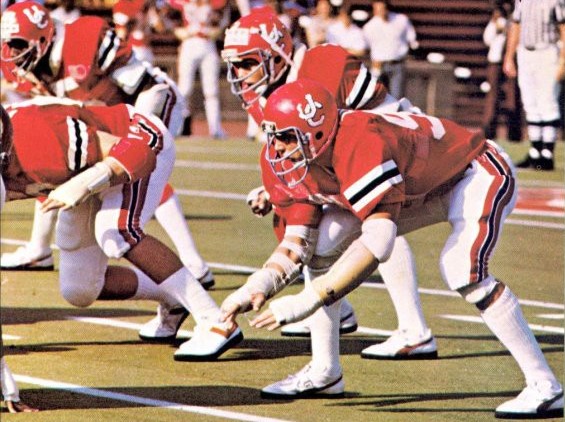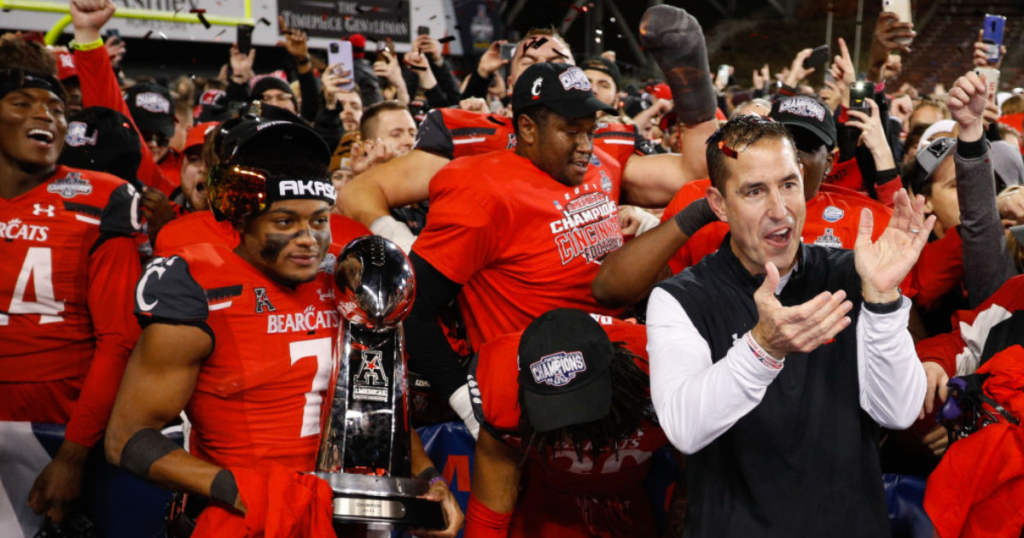Cincinnati in the CFP: The Have-Not is hanging out with the Haves

CINCINNATI – The Cincinnati Bearcats occupy that sweet spot in time before expectations sour accomplishment, before championships are demanded, before a College Football Playoff semifinal is taken for granted. Nick Saban doesn’t need to lecture Bearcats fans about entitlement.
Coach Luke Fickell turned around this program by focusing his considerable recruiting skills on what he calls “the state of Cincinnati.” It doesn’t take long to figure out that the state of Cincinnati these days is delirium.
It is all so new and exciting. Forget being ranked No. 4 and playing Saban’s No. 1 Alabama in the playoff on New Year’s Eve – Cincinnati never has played in a Cotton Bowl. The Have-Not is hanging with the Haves.
Last week, the CFP invited administrators from the semifinalists to Indianapolis for a site review of Lucas Oil Stadium. Cincinnati director of football operations John Widecan couldn’t get over the scoreboard. There, next to the crimson script A for Alabama, the yellow block M for Michigan, and the black G in the red oval for Georgia was the black C with the four claws.
“They had all our logos up,” Widecan said, the “gee whiz” in every syllable. “You know?”
Widecan arrived at Cincinnati as a graduate assistant in 1989 and never left. He has helped shepherd the program from independence to Conference USA to the Big East to the American, with the Big 12 on deck.
Widecan has worked for seven coaches. The first five left for better jobs. Here’s how the first one, Tim Murphy, defined “better job.” He went to Harvard – and took a $35,000 pay cut to do it.
In Murphy’s defense, he took over a Cincinnati program in 1989 that had just been busted for rules violations. The NCAA took away 13 football scholarships over three seasons. Cincinnati began the 1990 season with only 63 scholarship players (and in those days, the NCAA limit was 95, not the current 85). Angelo Colosimo, a former fullback at Colgate, took over that year as the Bearcats’ team physician.
“My first game, we lost at Penn State 81-0,” Colosimo said. “You couldn’t find a rock big enough to crawl under.”
Good news: In the fourth quarter, the Nittany Lion scout-teamers outscored the Bearcats by only 14-0.
The facilities reflected the size and ambition of the program. The football office was housed in the power plant, directly above the office for campus parking. The training room consisted of a space beneath the stands at Nippert Stadium. If you forgot where you were, banging your head on the concrete pillars above reminded you.
“There was dirt on the floor,” Colosimo said. “It was disgusting.”

The team stunk. Practices stunk. The campus incinerator towered above the stadium.
“If they would burn at the wrong time of the day,” recalled senior associate athletic director Bob Mangine, “during practice the soot would come down on you and the ashes would come down on you as you were practicing. And it would stink.
“Once that went away, the whole thing got a lot better.”
Mangine, 69, has spent most of his career as football and/or basketball trainer for the Bearcats. He came to the university in the mid-’70s from Pitt, in the glory days of Tony Dorsett.
“I never forget,” Mangine said, “the first home game we played, I looked at (head trainer) Bill Walker, and remember, the reference is that I came from Pittsburgh, where we had Pitt Stadium, which sat 69,000. And I looked around and I said, ‘Bill, when does everybody get here?’ We had 3,000 or 4,000 people in the crowd if we were lucky.
“Bill said, ‘This is it.’ ”
It got worse. By the late 1990s, when Maggie McKinley ran track for the Bearcats, “you could just wave at the usher and smile and come and take any seat you wanted,” she said. “You had sections to yourself.”
McKinley, now the senior women’s administrator for the Bearcats, said that in those days, the look of the university could be captured by the “B lot,” a parking lot that looked as if it belonged outside a mall.
“You had to get here by 7:30 a.m. to get a spot in that lot,” McKinley said. “It was just the ugliest thing. It was just so ugly — big, huge, black asphalt. You’d see cars driving up and down every aisle trying to find an empty spot every day.”
Today, where the “B lot” stood is mostly green space. Fans tailgate there, and the team walks to the stadium through the middle of it. When McKinley met with her college friends and teammates at Homecoming this season, the same people who used to walk into games couldn’t find a ticket.
Season-ticket sales will be capped next season at about 26,000. The Cincinnati area has fallen for the Bearcats, which runs counter to the fate of most football programs in NFL cities. The Houstons and Georgia Techs and Northwesterns of the world struggle to sell tickets and struggle for media attention.
Cincinnati, at its heart, is a parochial town, not just in the Catholic sense (there are close to 500,000 church members in the local archdiocese) but parochial as in insular. McCarthy said that if someone in Cincinnati asks you where you went to school, they mean high school. Brian Hatch, a finance professor who serves as the faculty athletic representative, said they mean grade school.
That feeling is what Fickell has tapped into better than any of his predecessors. And that feeling has played a huge role in the rise of the Bearcats. Cincinnati has more than its share of Ohio State fans. But the city never has been as attached to the Buckeyes as the rest of the state. The heavy Catholic population always loved Notre Dame. Archbishop Moeller High in Cincinnati even sent coach Gerry Faust to lead the Fighting Irish.
Top 10
- 1Breaking
Shedeur Sanders not drafted
Slide continues
- 2
10 Best Available Players
After Rounds 1-3 of NFL Draft
- 3
Picks by Conference
SEC, Big Ten continue to dominate Draft
- 4Hot
Jalen Milroe
Drafted before Shedeur Sanders
- 5Trending
Shedeur Sanders
Reportedly pranked by fake NFL team
Get the On3 Top 10 to your inbox every morning
By clicking "Subscribe to Newsletter", I agree to On3's Privacy Notice, Terms, and use of my personal information described therein.
Old-timers say that the Buckeyes never forgave the Bearcats for defeating them in the championship game of the 1961 and 1962 men’s Final Four. And Cincinnati, being hard on the Kentucky border, has weather and attitude more inclined toward the South than the rest of Ohio.
“I know that when I came here, there was a difference,” Fickell said. “The people that took pride in their city and their university I think didn’t want to be represented by Ohio State. ‘We’re different.’ ‘We’re separate.’ ‘We’re not big brother/little brother. We’re our own.’ I recognized that. We’re the state of Cincinnati.”

Fickell defines “the state of Cincinnati” as a 50-mile radius. He said Cincinnati is the only section of Ohio that he didn’t recruit during his 16 seasons as an Ohio State assistant. Fickell knew of the school as a child growing up in Columbus because his uncle, Joe Hiles, wrestled for Cincinnati. He had been on campus only once before he took the job.
“When my wife and I would envision taking a chance,” Fickell said of his time as defensive coordinator at Ohio State, “… we would just talk about it from time to time, she would always say, ‘I think Cincinnati would be great, … (T)hat would be a great place for our family.’ I don’t know if she knew anything about the program, the team or the school. But she was looking at something different.”
That stuck in Fickell’s head. When then-athletic director Mike Bohn arrived at Fickell’s home in Columbus to talk to him about the Cincinnati vacancy, the first words out of Fickell’s mouth were, “I want you to know that I want this job.”
“In any other interview that I’ve ever done,” Fickell said, “I’ve never said that.”
When Fickell arrived, Cincinnati hadn’t signed a player out of the local Catholic high schools in six years. His predecessor, Tommy Tuberville, recruited junior colleges and his native south.
“Our fans were actually — their feelings were hurt,” McKinley said. “When they looked at our roster, and they looked at where our recruits were coming from, they weren’t ones our fans could identify with.”
Luke and Amy Fickell put their six children in Catholic schools. They inserted themselves into the community. And the community has responded. There are 28 players from Cincinnati on the roster and another 10 from towns within “the state of Cincinnati.”
“I don’t know that we’ve gotten any [recruits] from my kids’ school,” Fickell said, “but that connection to the community in general, I think this community loves their community and I think some of that stuff does make a difference.”
Fickell said he has as many recruiting battles with Kentucky, where Mark Stoops has created success in large part because of his ability to recruit his native Ohio, as any school. The Cincinnatis and Kentuckys of the world don’t recruit the same caliber of athlete as the Ohio States, not to mention the Michigans, Georgias and Alabamas. That may be the greatest indicator of the Bearcats’ chance to upset the Crimson Tide.
Or this: Cornerback Sauce Gardner is the first Bearcats non-kicker/punter ever to become a consensus All-American. Alabama had three this season and 32 in the past decade. Coby Bryant, the Bearcats’ “other” corner, won the Jim Thorpe Award as the best defensive back in the nation. That is the second individual award ever won by a Cincinnati player. Alabama quarterback Bryce Young won four by himself this season.
And yet. In this greatest of all moments in Bearcats history, one way to measure success is the Trip Advisor newsstand in Concourse B at the Cincinnati/Northern Kentucky International Airport. On the November weekend that Cincinnati played SMU, the newsstand placed an entire table of Ohio State gear on a table outside the store, in the actual concourse. To find any Cincinnati gear, you had to walk into the store, turn around and look in the front corner, where one rack of Bearcats T-shirts stood next to one rack of Kentucky T-shirts.
Four weeks later, in the concourse next to the table of Buckeyes gear stood a rack of Bearcats Cotton Bowl T-shirts.